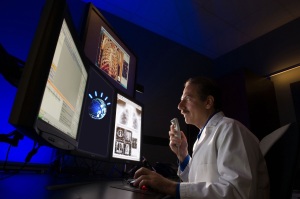by
John R. Fischer, Senior Reporter | November 25, 2019

Dr. Eliot Siegel says he hopes to see local
worklists in the next five years that will enable
radiologists to share images and reports with
clinicians in outside networks.
From the November 2019 issue of HealthCare Business News magazine
Dr. Eliot Siegel is surprised. More than 25 years ago, the Maryland-based radiologist could envision sharing images with not just other departments in his own network but with ones outside of it, in networks belonging to different providers and across vast geographies. He expected it to be the norm.
“Here we are more than a quarter century later, and we have images available within network but not among networks,” Siegel, chief of radiology and nuclear medicine for the Veterans Affairs Maryland Health Care System in Baltimore, and vice chair of information systems at the University of Maryland School of Medicine, told HCB News.
Creating such a system, he says, would boost healthcare interoperability to new heights, with radiologists able to send findings to referring clinicians in outside networks, who could then relay results to patients faster and begin treatment sooner. A number of barriers, however, still exist and affect not just the way they transmit and relay findings, but more importantly, how they interact with their patients.



Ad Statistics
Times Displayed: 6
Times Visited: 2 Fast-moving cardiac structures have a big impact on imaging. Fujifilm’s SCENARIA View premium performance CT brings solutions to address motion in Coronary CTA while delivering unique dose saving and workflow increasing benefits.
More access, more questions
Conversations between radiologists and patients conventionally take place through the referring physician, who was somewhat designated as the patient’s sole communicator. But with the arrival of patient portals, which allow patients to sign in to their electronic records in their hospital or network system and view their reports and images from the confines of their home or anywhere else, they rightfully have more questions than ever.
“Patients typically don’t understand what they are seeing when they review the images themselves, much less the meaning of the report,” said Siegel. “Review of their reports generates many additional questions due to the extensive and often necessary use of medical jargon.”
The development of the portals has pushed many sites to introduce waiting periods between when a study is interpreted by a radiologist and when it is made available to the patient. This ensures that clinicians have more time to discuss the findings with the patient before they view the images and reports themselves.
Online access to imaging exams have also led to more patients seeking direct meetings with their diagnosing radiologist, shifting the traditional role of the radiologist from someone who just reads images to one who is responsible for both reading and relaying findings. The extension of this role comes with the need to understand what should and should not be told to the patient, and how best to relay information.

